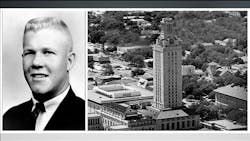On the day of the attack, August 1st, 1966, Charles Whitman rented a truck before he drove to a hardware store where he purchased an M1 Carbine, two magazines, and eight boxes of ammunition. Whitman then left from the store after telling the cashier that he planned to hunt wild hogs and went to a gun shop. There he purchased four more magazines, six more boxes of ammunition, and a can of cleaning solvent. From there Whitman went to a Sears and purchased a Sears Model 60 12-Gauge Semi-Automatic Shotgun and then proceeded to head home with his purchases. Inside his garage he sawed off the barrel of the shotgun and packed his footlocker with three rifles, the shotgun, and three pistols. The weapons consisted of a Remington 700 ADL, an M1 Carbine, a Remington Model 141, a Sears Model 60 Shotgun, a S&W Model 19, a Luger P08, and a Gales-Brescia. Whitman had also packed into the locker food, coffee, vitamins, Dexedrine (a commonly prescribed stimulant), Excedrin, water, earplugs, matches, rope, lighter fluid, three knives, a machete, binoculars, a radio, toilet paper, a razor, deodorant, and around 700 rounds of ammunition. Does it sound like he was preparing for a siege?
- - - - - - - - - -
The remainder of this article is part of the book "Active Killers and the Crimes They Perpetrated," available in print or ebook via Amazon.
About the Author

Joshua Borelli
Joshua Borelli has been studying active shooter and mass attack events over the course of the past several years, commensurate with receiving training on response and recovery to natural disasters and civil disturbances. Joshua started to outline this series of articles in an attempt to identify commonalities and logistical needs patterns for response.
